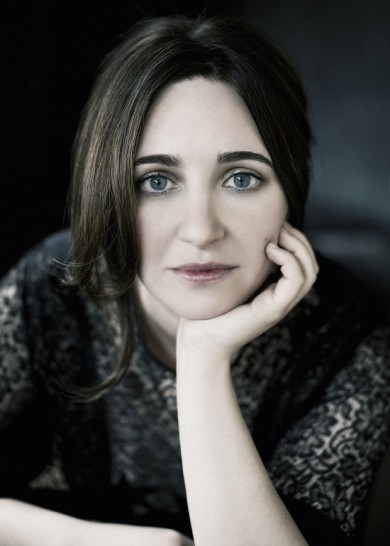Dinnerstein brings fire and feeling to Bach’s “Goldberg” Variations in Miami

Simone Dinnerstein performed Bach’s “Goldberg Variations” Sunday at the adrienne Arsht Center in Miami. Photo: Lisa Marie Mazzucco
Simone Dinnerstein created considerable excitement among pianophiles in 2007 with her self-produced recording of Johann Sebastian Bach’s Goldberg Variations. The recording received many critical accolades and launched Dinnerstein into a major international concert career. Now her signature piece, Dinnerstein played the iconic Bach masterwork Sunday evening for the Adrienne Arsht Center’s Knight Masterworks Series in Miami. Although it was the only work on the program, the concert was hardly insubstantial. Observing all of Bach’s repeats, Dinnerstein’s traversal lasted nearly ninety minutes.
In an effort to make the Knight Concert Hall more intimate for this solo Baroque score, the upper balconies were closed off and the acoustical canopy lowered. These adjustments were definitely beneficial to the performance, bringing a sense of immediacy and greater definition and clarity to the piano sound. Despite the music’s length and complexity, a large, quiet and highly attentive audience was clearly entranced by Dinnerstein’s performance and awarded her a lengthy ovation at the conclusion.
Composed in 1741, the Goldberg Variations were originally conceived for harpsichord. Many pianists have performed this work, adapting that instrument’s registrations to the modern concert grand in the twentieth century, Consisting of an aria and thirty variations, the music represents some of Bach’s most original, inventive keyboard writing. The left-hand bass line of the aria, which is repeated as the score’s coda, appears in each of the variations. Every third variant is a canon replete with dense counterpoint.
Dinnerstein’s recording was distinguished by its lyrical, reflective impulse, a fresh interpretive approach to a challenging score. Much of that was evident in her performance. Dinnerstein’s well-honed technique and sensitive touch are matched by bold musical instincts. Her rendering of the contrapuntal figurations was clean and transparent but, since the recording, Dinnerstein has taken some aspects of her approach to extremes. The fast sections were very rapid indeed. Although impressive as a demonstration of digital dexterity, Dinnerstein’s excessive tempos at times rendered the music cold and metronomic, verging on bombast in the 8th variation.
The score’s structural arc was not always clearly delineated, the contrasts of tempo and mood emerging in episodic fashion. Still Dinnerstein’s introspective, nuanced playing of the slow sections was often beautiful. There was an aching sense of sadness in her initial statement of the aria. She brought an almost improvisatory sensibility to the 9th variation, wonderfully dreamy and wistful. In the famous “Black Pearl” variation (No. 25), the depth of weight and drama Dinnerstein rung from the keyboard was deeply moving, at once grave and plaintive. Her soft, dulcet reading of the 28th variation was magical and the whirling lightness and vivacity of the dance like movements proved irresistible. Particularly in the later sections, Dinnerstein’s wide-ranging dynamic palette and spectrum of tonal colors enhanced Bach’s most eloquent writing.
While her conception lacks the mastery of line and pulse that artists like Murray Perahia and Andras Schiff bring to this score, Dinnerstein’s journey through the Goldberg Variations was never less than fascinating. She is clearly a gifted and thoughtful player. With greater musical maturity, she may find a more organic and cohesive approach to this elusive masterpiece.